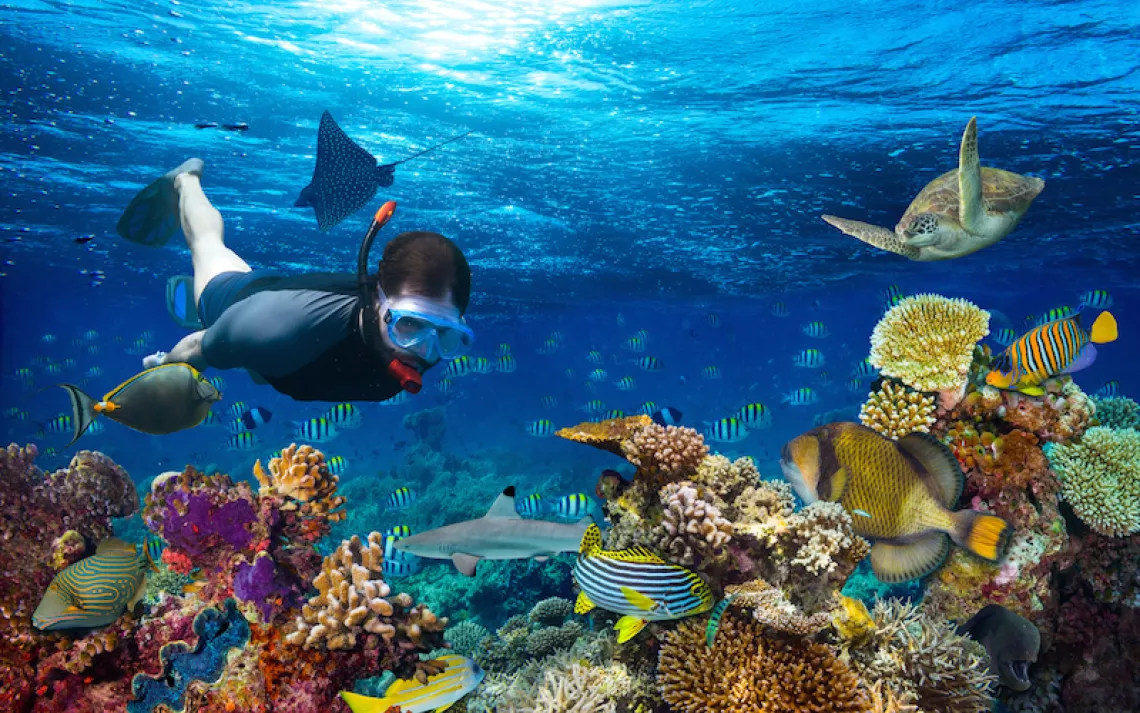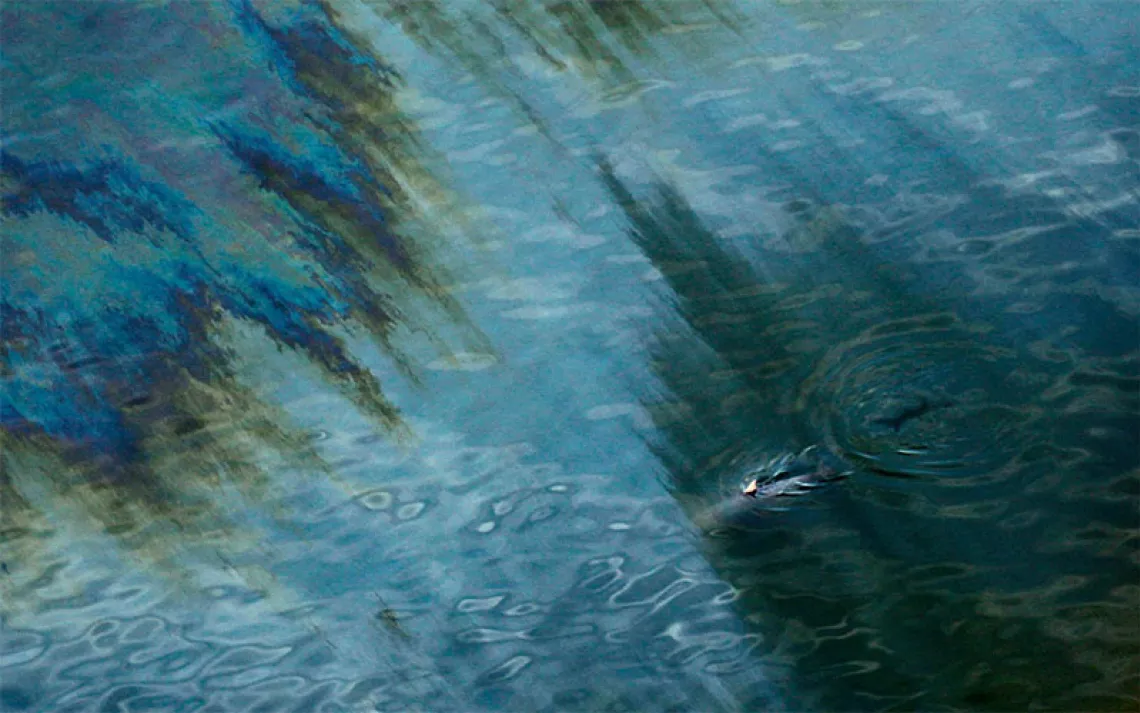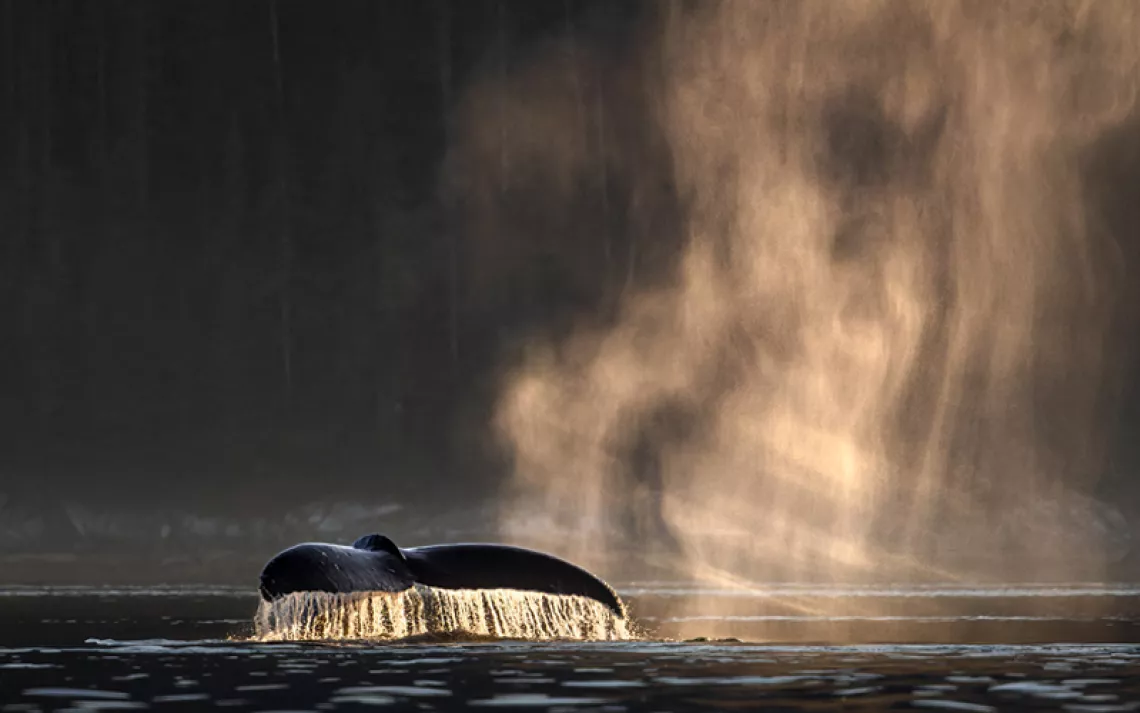Is Your Sunscreen Destroying Coral Reefs?
Here’s how to protect both the ocean and your keister
Even the savviest of sun chasers may need to rethink their sunscreen habits. While lathering up before taking to the great outdoors might protect your skin from the sun’s harmful UV rays, research shows that some 90 percent of sunscreens are taking a serious toll on the environment—contributing to the bleaching and inevitable death of coral. With reefs in historic decline, our beloved rainforests of the sea are under siege—and sunscreens are part of the problem.
Brian Guadagno, a longtime ocean lifeguard who in 2012 founded Raw Elements, a reef-safe sunscreen brand, explains that common sunscreen ingredients oxybenzone and octinoxate have proven to be toxic to living coral. While there are several known disruptors of coral and marine life, many of which are banned from eco-marine reserves, UV-protective oxybenzone, which also goes by benzophenone-3 and BP-3, has been under increased scrutiny since the Archives of Environmental Contamination and Toxicology published a paper in 2015 that reveals it as a genotoxicant for coral, meaning that it causes destructive mutations at a genetic level. Higher concentrations of the chemical also directly correlate with increased instances of coral bleaching, which is what happens when the symbiotic algae that live in coral and color it so beautifully are killed off, leaving a white skeleton in the coral’s place. “Oxybenzone and octinoxate are often used in 3 to 6 percent of the sunscreen formula, so it’s a significant amount,” Guadagno says.
Those findings have since prompted policymakers in Hawaii to introduce legislation that would ban the sale of sunscreens containing oxybenzone or octinoxate. The state legislature approved that measure on May 1, and last week, the Center for Biological Diversity petitioned the U.S. Food and Drug Administration to ban both chemicals. After all, it doesn’t take much chemical-laden sunscreen to adversely affect coral reefs—toxicity occurs even at a concentration equivalent to about one drop of water in an Olympic-size swimming pool. And with 14,000 tons of sunscreen entering the ocean every year, we’re seeing coral health decline at an alarming rate. That’s in part because you don’t even have to be touching the sea to be negatively impacting it. Whether enjoying crisp alpine air, desert vibes, or epic swell, at some point, you’re going to rinse off all that your skin’s collected—dirt, sunscreen, etc.—and that water will run into streams, rivers, and eventually, the ocean.
In essence, chemical sunscreens serve to amplify one of the worst effects of climate change in the sea: The primary cause of coral bleaching is rising sea temperatures, but oxybenzone, which becomes more toxic when exposed to sunlight, contributes to that bleaching while introducing other issues to the coral—DNA damage and death among them.
“Eighty-five percent of Caribbean reefs have disappeared in the past 50 years,” says Dr. Craig Downs, lead author on the 2015 paper and executive director of nonprofit Haereticus Environmental Laboratory. “Ninety-nine percent of the reefs in the Florida Keys have disappeared in the same amount of time, and 40 percent of the Great Barrier Reef has disappeared in the past 30 years.”

Sign up to receive Sierra News & Views
Get articles like this one sent directly to your inbox weekly.
With this action you affirm you want to receive Sierra Club communications and may vote on policy designated by the Sierra Club Board.
Why does this matter and what makes coral reefs important? Most scientists cite the ocean as the source of half the world's oxygen and a third of its carbon absorption—and while there's some debate as to the role reefs play in this positive gaseous exchange, everyone agrees that in terms of nominal value, coral reefs are the most important ecosystem the ocean provides. After all, NOAA estimates coral reefs’ economic value—which accounts for several factors including tourism and food production—to be in the realm of $30 billion annually.
Regardless of what makes corals important, there’s an undisputed point of agreement: We need coral reefs, and we need them healthy.
“The reef is like the supermarket of the entire ecosystem,” says Dr. Andrew Rossiter, executive director of the Waikiki Aquarium. It’s the basis for sustaining life, both below the ocean’s surface and above. And it’s remarkably easy for you to make a difference—a huge difference, in fact.
Yes, there are many other factors contributing to the harm of living corals, “but the clear point in fact now is that sunscreen is one of those contributors,” says Guadagno. It’s also one that we can easily address simply by choosing brands that whittle sunscreen down to the most basic, necessary ingredients that provide broad-spectrum protection without harming reefs.
Presently, more than 90 percent of sunscreens on the market contain one or more ingredients banned from reserves. Even those brands touted as “natural” aren’t necessarily a safe bet. Fortunately, identifying ecofriendly sunscreens is still easy—it’s all spelled out for you.
“Turn the package over, obviously,” says Guadagno. All the information you need is right there. Just as when shopping for food, seek out sunscreens that have fewer ingredients. Stay away from those that list oxybenzone or octinoxate, as well as any parabens. “The only true reef-safe ingredient is non-nano zinc oxide,” says Guadagno. “That should be the active ingredient. A lot of brands are adding that now, but check: Does it live with other active absorbers? Look at the inactive ingredients as well. Make sure they make sense to you and that you understand what they are.” To that end, Guadagno suggests also looking for trusted third-party certifications like Non-GMO Project, Leaping Bunny, and/or One Percent for the Planet seals.
Resorts that rely on the draw of the ocean are catching on to the safe sunscreen movement, too. In February, Aqua-Aston Hospitality, the largest hotel management group across the Hawaiian Islands, launched the #ForOurReef campaign to educate its 5 million annual visitors about the harmful effects of chemical sunscreens.
In addition to stocking guest rooms with complimentary Eco-Kits that include a tin of Raw Elements sun lotion, Aqua-Aston has outfitted 16 of its hotels across the state with Raw Elements sunscreen dispensers, and has plans in place to implement the program across its 40-plus properties by the end of the year. The soap-dispenser-style reef-safe sunscreen stations decorate the pool and check-in areas, in an effort to encourage guests to lather up safely.
It’s a lesson we can all take with us to the waves, the trails, and the farmers’ market: Efficacy doesn’t have to come down to a choice between protecting coral or your keister—it merely comes down to your choice of sunscreen.
This story has been modified since its original publication.
 The Magazine of The Sierra Club
The Magazine of The Sierra Club




